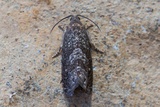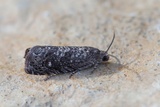Aspila molesta (Busck, 1916) Species
Last modified: July 1, 2025, 2:04 p.m.
Status in Belgium insufficiently known due to the similarity with Grapholita funebrana, but expected to be very rare.
What we know is that between 2004 and 2020 there was not any prove that the species occurs in Belgium (no genitalia were studied on claimed specimens of G. molesta, and even individuals that were atracted by pheromones of this species, turned out to be Grapholita funebrana after study of their genitalia).
At last in 2021, in a garden center, the species was confirmed in LI by examination of the genitalia.
Details
- Classification
- Family: Tortricidae > Subfamily: Olethreutinae > Tribus: Grapholitini > Genus: Aspila > Species: Aspila molesta
- Vernacular names
- Grijze fruitmot (NL), Oriental Fruit Moth (EN), Pfirsichtriebwickler (DE)
- First mention in Belgium
- Dufrane A. 1960. Microlépidoptères de la faune belge, (neuvième note). — Bulletin du Musée royal d'Histoire naturelle de Belgique 36(29): 1–16. On page 9. view page
- Status
-
Exotic In Belgium since August 1945.
First observation for Belgium: all larvae found at Mons in fruits imported from the South, 1 larva in peach on 25.viii.1945, 1 larva in apricot on 12.viii.1947 and 1 larva in a large yellow plum on 29.vii.1957 imported from Ravenna (Italy).
Grapholita molesta is thought to have originated in northwest China. It is currently widely distributed on all continents where stone-fruit is grown.
Distribution
Imago
Wingspan 11–14 mm. Forewings are dull grayish brown with a row of black dots near the apex and termen and a lighter dorsal area.
Adults are very similar to Grapholita funebrana and to a lesser extent to Grapholita tenebrosana so a genitalic dissection may be necessary to confirm species identity.
Egg
Slightly oval, translucent white initially, becoming amber with age.
Caterpillar
Early instars are whitish with a black head. Later instar larvae reach ca. 10–12 mm in length. Body pinkish with large pale pinacula. Head and prothoracic plate yellowish-brown. Pale brown anal plate without mottling. Anal comb with ca. 5 teeth.
Bionomics
The first generation drills in the spring in the tips of new shoots of fruit trees. The boring is maximum six cm deep. Infested shoots wither and die off, to compensate, the tree partially forms several new shoots.
The following generations harm the fruits in summer. Outer feeding marks appear or drill holes with frass can be seen on the calyx, stalk or between touching fruits.
In the case of stone fruit, rubber flow exits the boreholes. The larva limits its feeding activity on the pulp and rarely penetrates to the core house.
It hibernates as a larva, rarely in the soil but usually on tree trunks and main branches on the host tree.
The adults come to light and pheromones.
Flight periods
Abroad, the adults fly in two or three generations a year from late April towards mid-October.
Belgian confirmed observations during June, September and early October.
Observed on
- Host plant (species):
- Prunus persica and Prunus armeniaca
- Host plant (genera):
- Prunus, Pyrus and Malus
- Substrates:
- Orchards, fruit trees
The larva feeds on many species of Prunus, Malus, Pyrus. Also but less on Cydia oblonga, Chaenomeles and Photinia.
Habitat
It occurs in urban areas, gardens, parks and orchards.


